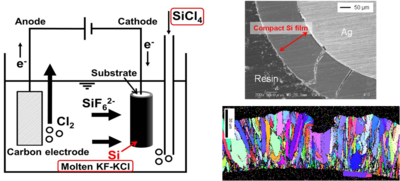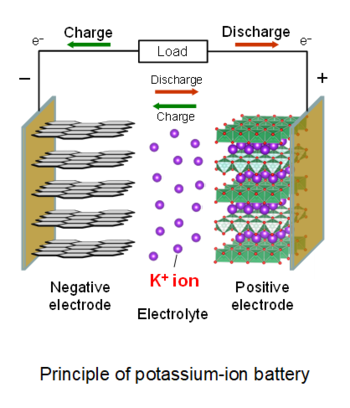Chemical Reaction Complex Processes
Advanced Energy Utilization Division Chemical Reaction Complex Processes Research Section
Junior Associate Professor : Takayuki YAMAMOTO
Professor(Concurrent) : Toshiyuki NOHIRA
Assistant Professor(Concurrent) : Yutaro NORIKAWA
We are studying materials and systems to realize renewable energies like photovoltaics as the major primary energy source for human beings. We are conducting innovative researches that cover the phases from basic research to applications mainly based on electrochemistry.
http://www.iae.kyoto-u.ac.jp/chemical/en/index.html
Development of New Production Process for Silicon Solar Cells Utilizing Molten Salt Electrolysis
Crystalline silicon solar cells are expected to be the mainstream for the mass-production of solar cells in the future, due to their high efficiency, high durability, non-toxicity and abundant resources. However, there are issues with the current manufacturing method for crystalline silicon solar cells, such as the large number of processes involved and the high energy consumption, as well as the fact that the supply chain is dependent on a specific country. We are researching a new manufacturing method for silicon solar cells that uses the molten salt electrodeposition method to directly produce crystalline silicon films on a substrate. With this method, it is possible to produce crystalline silicon solar cells at a lower cost and with lower energy consumption compared to the conventional method.
A new production method of silicon films for solar cells by the molten slat electrodeposition.

Development of Plating Process of Titanium Utilizing Molten Salt Electrolysis
To utilize surface properties of titanium and its alloys, a method to form a titanium film on the substrate has shown great promise. We are developing a plating method in molten salt as a method that enables uniform titanium deposition even on substrates with complex shapes.
Obtained Ti films with smooth surface by the molten salt electroplating

Highly Efficient Water Electrolysis Using Hydrate Melts
There is great anticipation for a "hydrogen energy system" that converts surplus renewable energy into green hydrogen through water electrolysis, stores and transports it, and then converts it back into electricity using fuel cells or hydrogen turbines. To respond to the full-scale introduction of renewable energy, it is important to improve the energy efficiency of water electrolysis. We are developing a highly efficient water electrolysis method using hydrate melt electrolytes, which are characterized by significantly lower water contents than ordinary aqueous solutions.
Highly efficient water electrolysis using hydrate melts.

Development of Next-Generation Batteries Using Highly-Safe Ionic Liquid Electrolytes
Renewable energy resources such as solar and wind power are intermittent resources, and their power generations are largely dependent on the weather. Thus, introduction of a large amount of renewable energy requires large-scale power storage systems such as large-sized batteries. Although current lithium-ion batteries are candidates for large-sized batteries, scarce resources (lithium, cobalt) and flammable electrolytes (organic solvents) are used as main components, which will be a major barrier for the widespread distribution in the future. Therefore, we are now developing next-generation batteries utilizing abundant resources (sodium, potassium, etc.) and safer electrolytes (ionic liquids).
Principle of potassium-ion battery









